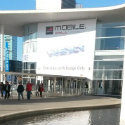
The Mobile World Congress numbers are in, and they are better than feared but worse than hoped for. Attendees cartwheeling through an empty Hall 3 had reckoned between 5,000 and 10,000 people came to the show, well below the GSM Association's target of 30,000 to 50,000. The reality appears to have been somewhere just north of 20,000.
The good news is that more than 100,000 people tuned in virtually for at least part of the show, putting overall attendance at pre-coronavirus levels. Unfortunately, a virtual pass was available for just €399 ($472), some €300 ($355) less than the cheapest physical pass. On that basis, undershooting the most pessimistic target by 10,000 visitors could mean foregoing about €3 million ($3.6 million) in revenues – unless people bought physical tickets they never used.
Figure 1: MWC attendance over the years  Source: GSMA
Source: GSMA
The big unknown is how many visitors were international and how many were even in telecom. Spain's Telefónica clearly sent more representatives than Germany's Deutsche Telekom, whose top executives preferred to participate by video link. Trying to boost numbers, the GSMA had offered 30,000 tickets to Spanish companies in sectors adjacent to telecom, priced at just €21 (around $25) apiece. It promised a €300,000 ($354,762) donation to Spanish vaccination efforts if the tickets were sold.
Not all were, evidently. But if thousands of visitors paid only €21 each for a ticket, the show finances would look even worse. Asked how many visitors were not from Spain, and whether the GSMA would still make its €300,000 donation, a spokesperson said more information would be forthcoming later this week.
Adapting to a new normal
The real danger is that two years without a full-blown MWC has weakened the appetite for one. Companies have now had ample time to adjust to the absence of the monster tradeshow, just as they have adapted to the working-from-home phenomenon. And just as organizations have realized their employees do not have to come to an office to be productive, many telecom firms have figured out how to market and sell effectively minus a physical presence at MWC. Last year was one of Ericsson's best in recent memory.
The GSMA plans to hold MWC 2022 at the usual time of late February to early March, meaning it is now less than eight months away. One guarantee is that the coronavirus will not have disappeared. While vaccines will have been more widely deployed, thousands of former attendees will probably not travel because of ongoing restrictions and deep-seated anxiety about the virus. The emergence of new vaccine-resistant variants is the biggest health-related threat to the show.
Want to know more about 5G? Check out our dedicated 5G content channel here on Light Reading.
But if the coronavirus situation improves, an MWC 2022 with substantially fewer than 100,000 visitors could point to a mindset change about large international events. There was already some ill will toward the GSMA, with exhibitors complaining about the exorbitant rates they have had to pay for an MWC presence. If that no longer seems necessary, they will be in no hurry to return. Belt-tightening accountants would be happy to delete the Barcelona expenses row from their spreadsheets.
At least the big exhibitors that stayed at home in 2021 have promised they will be back in 2022. The GSMA reels off a list of confirmations that includes many old-time favorites and a few newer faces – Ericsson, Nokia and ZTE on the infrastructure side, Samsung and Xiaomi for devices and Dell and Intel for IT hardware and chips. Curiously enough, there was no mention of Huawei.
Related posts:
— Iain Morris, International Editor, Light Reading
About the Author(s)
You May Also Like











